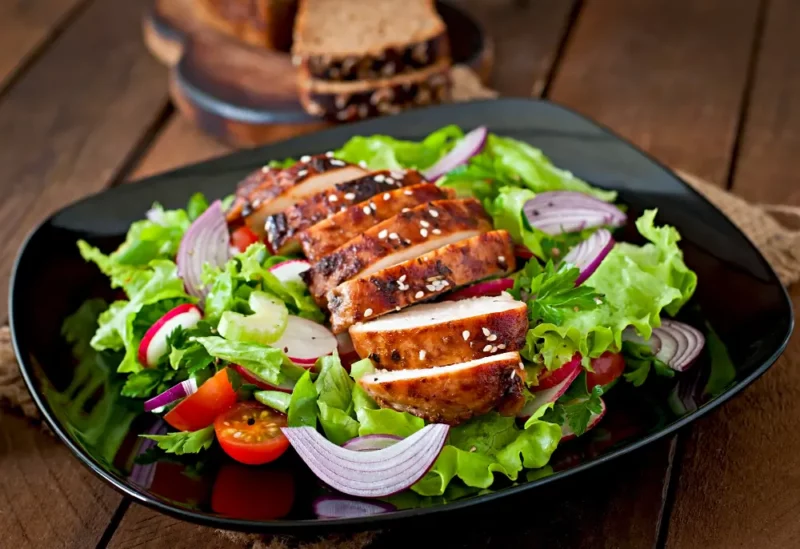Are you tired of searching for the best diet plan for weight loss for females – as in a weight loss solution that actually works and lasts? Do you feel like the generic approaches out there don’t consider the specific challenges women face?
Well, I’ve been through it, and I get how tough it can be to lose those stubborn pounds.
So, let’s change it up and talk about weight loss in a way that makes sense. We’ll look at why typical diets don’t quite cut it, understand why weight loss matters for women, and discover what makes the best diet plan for weight loss for a woman – not just for today but for a healthier future.
We’ll break down the process and highlight the importance of your approach, making it sustainable, and taking a well-rounded view for a journey toward better health. Stick around for practical tips that anyone can follow starting today!
Weight Loss for Women: Hormonal Influences

Hormonal Factors and Their Impact
The journey of weight loss for a woman is linked with hormonal fluctuations, which play a significant role in metabolism, energy utilization, and fat storage. So yeah, pretty much everything. Understanding these hormonal influences is important for making effective decisions.
Menstrual Cycle and Metabolism
The menstrual cycle introduces an incredibly dynamic interplay of hormones, notably estrogen and progesterone. Studies show that the menstrual cycle can influence basal metabolic rate (BMR) and energy expenditure.
During the follicular phase (pre-ovulation), the metabolic rate tends to be slightly higher, while in the luteal phase (post-ovulation), there is a potential increase in calorie expenditure, albeit a modest one. Interesting, isn’t it?
Insulin Sensitivity and Hormones
Hormonal fluctuations, especially during the luteal phase, can impact insulin sensitivity. Increased insulin resistance during this phase may affect the body’s ability to efficiently utilize glucose, potentially influencing cravings and energy levels.
How to Use Hormonal Variability for Weight Loss
Sounds pretty complicated, right? Not exactly. Let’s break it down and see how we can use it to our advantage when it comes to healthy weight loss for women everywhere.
Adjusting Your Calories
Acknowledging the metabolic fluctuations throughout the menstrual cycle, adjusting caloric intake can be a smart approach. During the follicular phase (pre-ovulation), when the metabolic rate may be slightly higher, a slight increase in caloric intake may be considered. In other words, it would be okay to consume slightly more calories. So don’t feel guilty about an extra craving or two.
In contrast, during the luteal phase (post-ovulation), when insulin sensitivity may be reduced, focusing on nutrient-dense foods and mindful eating becomes important.
What Exercises to Do
Creating exercise routines to align with hormonal changes can actually optimize results. During the follicular phase, incorporating high-intensity interval training (HIIT) or strength training can capitalize on increased energy levels. In the luteal phase, gentler exercises like yoga or moderate cardio may be preferable, considering potential fluctuations in energy and mood.
On a side note, I’m trying to get exercise & fitness platforms like fitblendr to accommodate these routines in their algorithms, so stay tuned for some exciting information about that.
Nutrient Timing
Smart nutrient timing, especially around workouts, can enhance weight loss efforts. Ensuring an adequate intake of protein, carbohydrates, and healthy fats during specific phases of the menstrual cycle supports energy levels, muscle recovery, and overall well-being.
In other words, eating the right foods at the right time around your workout routine can enhance weight loss.
Emotional Eating and Weight Management

Serotonin and Emotional Well-being
Serotonin is a neurotransmitter often associated with mood regulation. Importantly for us, it is influenced by hormonal changes (because of course it is). The drop in serotonin levels during the premenstrual phase may contribute to emotional fluctuations and cravings for comfort foods.
Incorporating serotonin-boosting foods like whole grains, nuts, and legumes may help stabilize your mood. So, if you feel the need to give into those hunger cravings, try to consume more of these foods as they have health benefits specific to your body’s needs.
Ghrelin and Hunger Regulation
Ghrelin, known as the “hunger hormone,” can vary throughout the menstrual cycle. Studies suggest that ghrelin levels may be higher during the follicular phase, potentially influencing appetite. Understanding these fluctuations can aid in creating a dietary strategy that addresses hunger cues appropriately.
Why Do Most Diet Plans Fail?
Pitfalls of One-Size-Fits-All Solutions
Conventional diet plans often adopt a blanket approach, assuming that what one considers the best diet plan for weight loss for one woman will work for all of us. However, our bodies are unique, each with its metabolism, genetic predispositions, and responses to food.
Scientific studies, such as those conducted by the National Institutes of Health (NIH), emphasize the variability in individual metabolic rates. Genetic factors, including variations in certain genes related to nutrient metabolism, can influence how individuals respond to different dietary approaches. A one-size-fits-all solution fails to consider these critical points.
Moreover, a study published in the Journal of the American Medical Association (JAMA) revealed that individuals’ responses to specific diets can vary widely. The study concluded that there is no universal “best” diet; instead, effectiveness depends on factors such as insulin sensitivity, genetic makeup, and microbial composition in the gut.
Unrealistic Expectations
One of the significant downfalls of many diet plans is the promise of rapid, dramatic weight loss. However, such expectations often lead to disappointment and, in some cases, abandonment of the plan altogether. Sustainable body trim is gradual, and scientific evidence supports this notion.
The American Journal of Clinical Nutrition published a study demonstrating that slow and steady weight loss is more effective for long-term weight maintenance. The study showed that individuals who lost weight gradually were more likely to sustain their weight loss over time compared to those who experienced a rapid process.
This can be attributed to the body’s adaptive mechanisms and the importance of forming sustainable habits. In other words, our bodies are outsmarting us. Which is both really cool and disappointing at the same time.
Emotional and Psychological Aspects
Weight loss is not solely physical; it is tied to emotional and psychological well-being. Stress, emotional eating, and mental health all play significant roles in the success or failure of a diet plan.
The physiological connection between stress and weight gain is well-documented. When the body experiences stress, it releases cortisol, a hormone that can lead to increased fat storage, particularly in the abdominal area. Chronic stress can disrupt appetite regulation, leading to overeating and poor food choices.
The Criteria for the “Best Diet Plan for Weight Loss”
Individual Needs are Important!
The best diet plan involves a deep understanding of individual needs, and recognizing the relationship between genetics, metabolism, and lifestyle. Basically, it has to be for YOU. Our bodies differ in how they process and utilize nutrients, a phenomenon known as bio-individuality. This understanding forms the bedrock of effective weight loss.

Genetics Plays a Role
Genetic factors influence how our bodies respond to different foods. A study published in the “American Journal of Clinical Nutrition” highlighted that individuals with specific genetic variations might respond better to certain dietary patterns. Making a diet plan based on genetic predispositions enhances its efficacy.
Beyond genetics, metabolism plays a key role. Women, owing to hormonal variations as we explained before, experience fluctuations in metabolism throughout their menstrual cycle. Research in the “International Journal of Obesity” suggests that aligning dietary strategies with these hormonal shifts may optimize weight loss efforts.
It Has to Be Sustainable
The concept of sustainability extends beyond environmental considerations; it’s a critical element in making an effective weight loss plan. Sustainability, in this context, refers to the ability to maintain dietary practices over the long term without causing undue stress or deprivation.
Psychological Aspects of Sustainability
A study in the “Journal of the Academy of Nutrition and Dietetics” found that gradual, sustainable changes in dietary habits led to better long-term adherence. This is different from the often-promoted quick fixes and crash diets you probably see everywhere, while emphasizing the importance of a steady, sustainable approach.
Your brain plays a role in regulating appetite and food choices. Neuroscientific research published in “Nature Reviews Neuroscience” indicates that establishing sustainable habits rewires the brain’s reward system, making it more receptive to healthier choices over time. So slow and steady will win the race.
Mind-Body Connection
The mind-body connection is well-established in scientific literature. Stress, for instance, releases cortisol, a hormone linked to increased abdominal fat. A review in “Psychosomatic Medicine” emphasizes that stress management techniques, such as mindfulness and meditation, can positively impact weight loss by mitigating the effects of stress hormones.
Emotional well-being directly influences eating behaviors as well. Research in “Appetite” suggests that cultivating a positive body image and addressing emotional eating through therapeutic interventions contribute significantly to sustained weight loss.
Components of an Effective and Best Diet Plan for Weight Loss
Okay, great. So, what does all this mean? And how will it help us actually put together a diet plan that will help lose weight?

Nutrient-Rich Foods
Balanced nutrition forms the heart of an effective diet plan, and understanding the scientific basis behind nutrient-rich foods helps illuminate the path to sustainable weight loss.
Going into the specifics, consider the importance of macronutrients—proteins, carbohydrates, and fats. Proteins, often hailed as the building blocks of life, play a crucial role in weight loss. Scientific studies demonstrate that a higher protein intake induces a feeling of fullness, reducing overall calorie consumption.
Additionally, the thermic effect of food (TEF) is higher for protein, meaning the body expends more energy digesting it, contributing to increased calorie expenditure.
Carbohydrates, often viewed with skepticism in weight loss circles, are indispensable for energy. However, not all carbs are created equal. Choosing complex carbohydrates with a low glycemic index stabilizes blood sugar levels, reducing cravings and promoting a steady release of energy.
Fiber-rich fruits, vegetables, and whole grains are excellent choices, with research indicating a positive correlation between high fiber intake and weight loss.
Fats, too, play a key role. Contrary to the misconception that fats should be avoided, healthy fats are essential for bodily functions and satiety. Omega-3 fatty acids, found in fatty fish like salmon and walnuts, have been linked to improved outcomes.
They not only enhance metabolic rate but also modulate inflammation, potentially impacting its success.
Exercise and Physical Activity
Making a workout routine tailored to the female body involves understanding the connection of hormones, metabolism, and energy expenditure.
Cardiovascular exercises, such as brisk walking or jogging, activate the cardiovascular system, leading to increased calorie burn. Scientific studies highlight the effectiveness of moderate-intensity cardio in promoting fat oxidation, contributing to weight loss.
Moreover, these exercises stimulate the release of endorphins, fostering a positive mindset and reducing stress—a key factor in preventing emotional eating.
Resistance training to complement the best diet plan for weight loss for female is often overlooked in some weight discussions but is a scientific cornerstone. Building lean muscle through resistance exercises not only enhances basal metabolic rate (BMR) but also contributes to a toned physique.
The research underscores the importance of combining aerobic and resistance training for comprehensive weight loss and overall health benefits.
Tips and Strategies: Nourishing Your Body
Building Healthy Habits
Incorporating nutrient-rich foods into daily meals involves a strategic and informed approach. A well-balanced diet not only fuels the body but also optimizes its natural processes. Consider a more detailed sample meal plan that aligns with nutritional requirements for women:
Breakfast

- Oatmeal with Berries and Chia Seeds: Oats provide complex carbohydrates for sustained energy, while berries offer antioxidants and fiber. Chia seeds contribute omega-3 fatty acids for brain health.
- Greek Yogurt with Honey: Greek yogurt is rich in protein, supporting muscle maintenance, and honey adds natural sweetness without refined sugars.
- Green Tea or Black Coffee: These beverages provide antioxidants and a mild caffeine boost for alertness.
Lunch

- Grilled Chicken or Tofu Salad: Lean proteins like grilled chicken or tofu aid in muscle development. A colorful salad with various vegetables ensures a spectrum of vitamins and minerals.
- Quinoa or Brown Rice: These whole grains supply essential nutrients and fiber, promoting satiety.
- Fresh Fruit for Dessert: Nature’s candy offers sweetness with added vitamins and fiber.
Dinner

- Baked Salmon or Plant-Based Protein: Fatty fish like salmon contribute omega-3 fatty acids, supporting heart health. Plant-based proteins, such as lentils or chickpeas, offer a satisfying alternative.
- Steamed Vegetables or Mixed Stir-Fry: Various vegetables provide diverse nutrients and adds volume to the meal.
- Sweet Potato or Whole-Grain Roll: Complex carbohydrates like sweet potatoes provide sustained energy, and whole-grain rolls offer fiber.
Overcoming Common Obstacles
Plateaus in weight loss, often frustrating, can be better understood through the lens of metabolism. As the body adjusts to a lower weight, it may reduce energy expenditure. To overcome plateaus, consider the following scientific-backed strategies:
Variety in Workouts
The body adapts to routine, leading to decreased calorie burn. Incorporating a mix of cardiovascular exercises, strength training, and flexibility routines challenges the body and prevents adaptation.
Tip: Vary your workout routine by using the custom exercise routine mixer on fitblendr to prevent your body keeping you at a plateau.
Calorie Adjustments
As weight decreases, the body’s caloric needs also diminish. A slight reduction in daily caloric intake, around 100-200 calories, can reignite weight loss without causing deprivation. Going with drastic calorie reductions is a surefire way to cause a diet to fail.
Intermittent Fasting
Research suggests that intermittent fasting can have metabolic benefits, such as improved insulin sensitivity and increased fat oxidation. However, it’s essential to choose a fasting schedule that aligns with individual preferences and lifestyles.

Social Situations and Mindful Choices
Coming across social situations often involves confronting tempting yet less nutritious food options. Planning and making mindful choices based on scientific principles can help maintain progress:
- Bringing healthy snacks like nuts, seeds, or cut-up vegetables to social events provides alternatives to less nutritious options.
- When dining out, choosing grilled or baked options over fried, and opting for side salads or vegetables instead of fries, aligns with healthy eating goals without sacrificing your enjoyment.
- Staying well-hydrated not only supports overall health but can also prevent overindulgence. Drinking water before a meal contributes to a feeling of fullness.
Workouts, Fitness & Meal Plans
Recommended Workouts and Fitness Plans

Workout routines to the specific needs of women involve understanding the unique physiological and hormonal aspects that influence fitness outcomes. Scientific studies consistently emphasize the benefits of combining cardiovascular exercises and strength training for optimal weight loss and overall health.
Cardiovascular Exercises
Brisk Walking or Jogging (30 minutes, 3 times a week): Scientifically proven to enhance cardiovascular health, brisk walking or jogging engages large muscle groups, promoting calorie burn and improving metabolism.
Cycling or Spinning Classes: Cycling is effective in reducing body fat percentage and improving aerobic capacity. High intensity spinning classes, in particular, can lead to significant calorie expenditure.
Jump Rope for High-Intensity Intervals: High-intensity interval training (HIIT) with a jump rope has been linked to increased post-exercise calorie burning, aiding in weight loss. It also enhances cardiovascular fitness.
Strength Training

Bodyweight Exercises (Push-ups, Squats, Lunges): Building lean muscle mass through bodyweight exercises contributes to a higher resting metabolic rate. This means the body continues to burn calories even at rest.
Resistance Training with Dumbbells or Resistance Bands: Scientific studies confirm that resistance training is essential for preserving lean muscle mass during weight loss, preventing a decrease in metabolism.
Yoga or Pilates for Flexibility and Core Strength: These exercises enhance flexibility, and core strength and contribute to stress reduction. Scientific evidence links stress reduction to improved outcomes.
Healthy Recipes and Meal Plans
Diet plays an important role in weight loss, and understanding the scientific principles behind nutrient-rich meal plans is key. Consider the following recipes:

Quinoa Salad
Nutrient Density of Quinoa: Quinoa is a complete protein source, providing all essential amino acids. Its high fiber content promotes satiety, reducing overall calorie intake.
Antioxidant-Rich Vegetables: The colorful mix of vegetables contributes to a variety of antioxidants, supporting overall health and aiding in weight management.
Healthy Fats from Olive Oil: The dressing with olive oil not only enhances flavor but also provides monounsaturated fats, which have been associated with improved heart health.
Stir-Fried Tofu with Vegetables
Plant-Based Protein from Tofu: Tofu is rich in plant-based protein, promoting muscle maintenance during weight loss. It also contains isoflavones, which may have metabolic benefits.
Fiber and Micronutrients from Vegetables: The assortment of vegetables adds fiber and essential micronutrients, contributing to digestive health and overall well-being.
Baked Chicken with Lemon and Herbs
Lean Protein from Chicken: Chicken breast is a lean protein source that aids in muscle preservation during weight loss. Protein-rich diets are linked to increased feelings of fullness.
Antioxidants from Herbs: Herbs not only enhance flavor but also provide antioxidants, supporting the body’s defense against oxidative stress.
Final Words
Simply put, finding the best diet plan for weight loss for a female is like going through a big change that’s more than just looking at the numbers on a scale. It’s about making a life full of energy and self-love. We’ve talked about how hormones, generic plans that don’t work, and a total approach that includes the body, mind, and feelings are all part of losing weight.
As we finish, let this be a strong message for all women – may your journey be full of strength, self-discovery, and always aiming for good health.
The Best Diet Plan for Weight Loss is Backed by Science (References)
The impact of intermittent fasting on weight loss and metabolic health: a critical review.
Dietary Protein: A Satiating Nutrient with Diverse Roles in Weight Management and Metabolic Health
Dietary Pattern Analysis and Its Application to Personalized Nutrition and Weight Management
Long-Term Weight Loss Maintenance: A Meta-Analysis of Behavioral Interventions
The Role of Exercise in Weight Management and Prevention of Chronic Diseases
